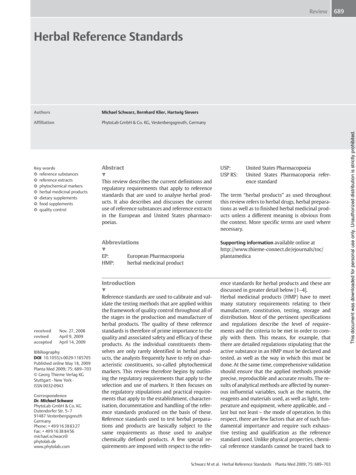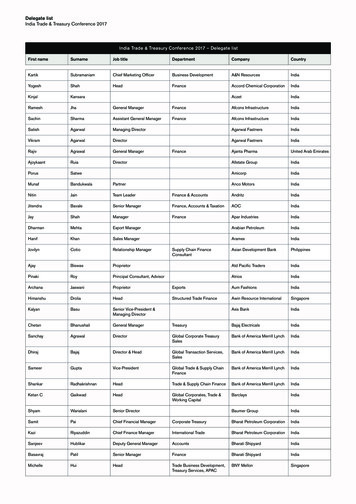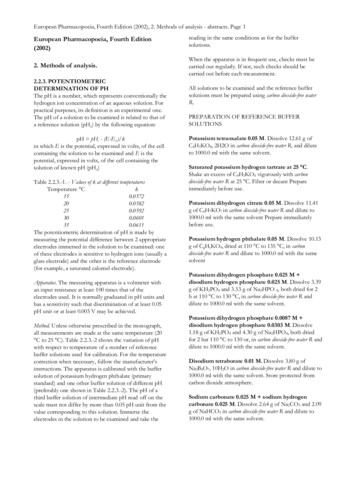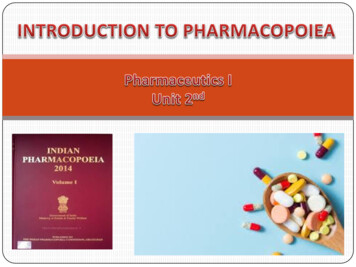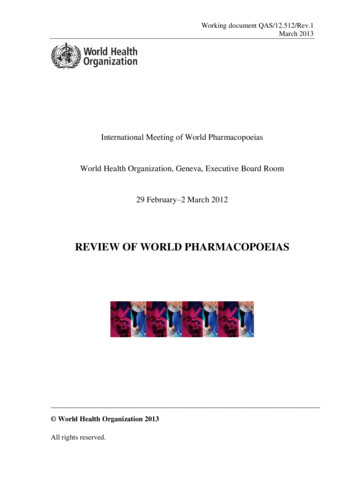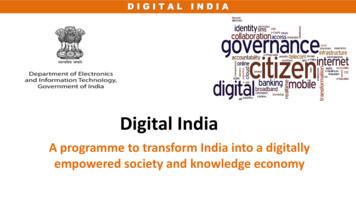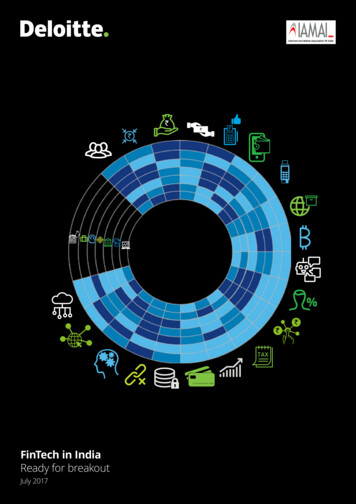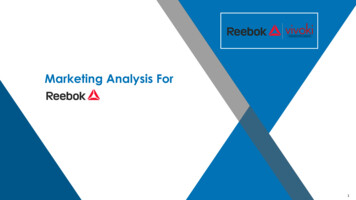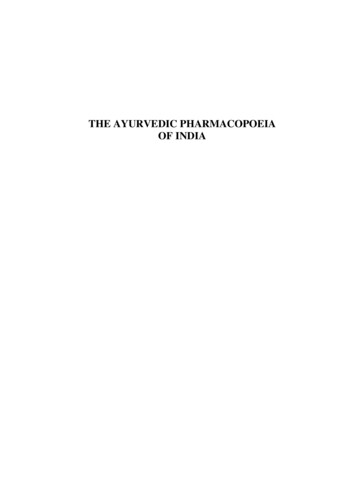
Transcription
THE AYURVEDIC PHARMACOPOEIAOF INDIA
THEAYURVEDICPHARMACOPOEIAOFINDIAPART - IVOLUME - VII(MINERALS & METALS)First EditionGOVERNMENT OF INDIAMINISTRY OF HEALTH AND FAMILY WELFAREDEPARTMENT OF AYURVEDA, YOGA & NATUROPATHY, UNANI,SIDDHA AND HOMOEOPATHY,NEW DELHI2008
PDH.66. Part I, Vol VII5000-2008 (DSK II) 2008, Ministry of Health and Family WelfareGovernment of IndiaDepartment of Ayurveda, Yoga – Naturopathy, Unani, Siddha & Homeopathy(AYUSH)Effective from 1st January, 2009Price:InlandForeignRs. 500/US 100/-ISBN:978-81-905952-2-3Published by:THE CONTROLLER OF PUBLICATIONSCIVIL LINES, DELHI - 110054On Behalf of:GOVERNMENT OF INDIADEPARTMENT OF AYURVEDA, YOGANATUROPATHY, UNANI, SIDDHA ANDHOMOEOPATHY (AYUSH), INDIAN REDCROSS SOCIETY BUILDING, SANSADMARG, NEW DELHIWEBSITE:www.indianmedicine.nic.inPrinted at:Cirrus Graphics Pvt. Ltd, New Delhi
Foreword
CONTENTSPAGELEGAL NOTICESGENERAL NOTICESPREFACEACKNOWLEDGEMENTINTRODUCTIONSPECIAL INTRODUCTION ɺiÉÉ ānta LauhaKāśīśaKha ikāMa ² raRajataSāmudra Lava aSauvirā janaSvar aSvar amāk¾ikaSvar amāk¾ika SāndritaTāmra a ka aTutthaVaikrāntaAPPENDIX - 1.1.1.1.1.1Physical Properties of Minerals and Metals(Definitions of Geological Terminology and Methodsof Determination of Various Parameters)NatureState of 15353
2.1.13.Crystal ht Transmission (Transparency)MagnetismHardnessSpecific Gravity (Density)FluorescenceXRD AnalysisAPPENDIX -2.2.1.2.2.2.3.2.4.2.4.1.2.4.2.2.4.3.2.5.Optical Properties of Minerals and Metals(Definitions and Methods of Determination)ApparatusReagentsMixturesRefractive Index (R.I)DefinitionPrincipleMethod of Determination of R.I.Method of Determination of Other ConstantsAPPENDIX - 3.Chemical Properties of Minerals and Metals(Description of Various Methods of ChemicalAnalysis and Other 67713.1.Chemical analysis of rock/ore samples by Classical Methods(Gravimetric-Wet on of powdered sampleDetermination of Loss on Ignition (LOI)Determination of Silica (SiO2)Determination of Iron (Fe)Determination of Calcium Oxide (CaO-EDTA)- complexometricmethodDetermination of Magnesium Oxide (MgO-EDTA)complexometric methodDetermination of Alumina (Al2O3-EDTA complexometric method)73737374753.1.6.3.1.7.7576
rmination of Sulphur (total)- (Gravimetric method)Determination of Lead, Zinc and Copper (complexometric method)Determination of LeadDetermination of ZincDetermination of CopperDetermination of Chloride in Sodium Chloride (Common Salt)7777787879793.2.Chemical analysis of rock/ore samples by Instrumental Methods803.2.1.Determination of Silver by Atomic Absorption Spectroscopy(A.A.S.)Determination of Copper, Lead, Zinc, Nickel, Cobalt and Cadmiumby A.A.S.Determination of Tin by A.A.S.Determination of Antimony by A.A.S.Determination of Bismuth by A.A.S.Determination of Gold by A.A.S.Determination of Chromium by A.A.S.Determination of Arsenic (Gutzeit method)Determination of Mercury by cold vapour Atomic AbsorptionSpectrophotometer (Mercury Analyzer)Determination of Gold and Silver by XRF (X-Ray FluorescenceSpectrometry)Determination of small amount of Titanium (TiO2) bySpectrophotometric methodDetermination of Manganese (MnO) by Spectrophotometric methodEstimation of Na2O and K2O by Flame PhotometryDetermination of Boron by ICPA803.3.Methods of determination of other important ination of Acid- InsolubleReaction with Hydrochloric Acid, Nitric Acid and Sulphuric AcidEffect of HeatQualitative test for Carbonate and Sulphate878788883.4.Qualitative chemical tests of minerals by Blow Pipe Method883.4.1.3.4.2.3.4.3.3.4.4.Essence and potentialities of the methodStructure of candle flameFlame colourationsCharcoal 8182828383848585868787
3.4.5.3.4.5.i3.4.5.ii3.4.6.3.4.7.Closed Tube and Open Tube TestsClosed Tube TestOpen Tube TestColour Reactions with FluxesRecommended Procedure of Blowpipe Tests9191919192APPENDIX - 4.Chemicals and Reagents95APPENDIX - 5.Classical Ayurvedic References123APPENDIX - 6.Bibliography141APPENDIX - 7.Coloured Photographs of Raw Drugs147
LEGAL NOTICESIn India, there are laws dealing with drugs that are the subject of monographs whichfollow. These monographs should be read subject to the restrictions imposed by these lawswherever they are applicable.It is expedient that enquiry be made in each case in order to ensure that the provisionsof the law are being complied with.In general, the Drugs & Cosmetics Act, 1940 (subsequently amended in 1964 and1982), the Dangerous Drugs Act, 1930 and the Poisons Act, 1919 and the rules framed thereunder should be consulted.Under the Drugs & Cosmetics Act, the Ayurvedic Pharmacopoeia of India (API),Part-I, Vol. VII, is the book of standards for Single Drugs of Minerals, Metals and Marineorigin included therein and the standards prescribed in the Ayurvedic Pharmacopoeia of India,Part-I, Vol. VII, would be official. If considered necessary, these standards can be amendedand the Chairman of the Ayurvedic Pharmacopoeia Committee authorized to issue suchamendments. Whenever such amendments are issued, the Ayurvedic Pharmacopoeia of India,Part-I, Vol. VII, would be deemed to have been amended accordingly.X
GENERAL NOTICESThese General Notices provide basic guidelines to help, interpret the provisions andterms used in this volume, in connection with the implementation of the recommendedstandards and methods of tests prescribed therein. In addition, they also include the features ofa monograph that are mandatory standards.Title: The title of this book is "Ayurvedic Pharmacopoeia of India, Part-I, Vol.VII (Mineralsand Metals)". Monographs on twenty-one raw drugs (minerals / metals / ores) are included inthis volume.Monograph: Each Monograph carries prescribed mandatory standards and generalinformation, including those from Ayurvedic Classics. The Monographs are arranged in theEnglish alphabetical order, based on the main Samskŗta official name.Monograph Title: The title given on top of each monograph indicates the name of thematerial in Samskŗta, and is the same as mentioned in the single drugs list on the AyurvedicFormularies for Minerals, Metals and Ores. It is the "Official Name" along with synonyms inSamskŗta. This is followed by a scientific nomenclature in English that is nearest and mostappropriate to the article described, and is also "Official".Synonyms: Taking into account the multilingual nature of the country, other names of thedrug have been listed in Indian languages other than Samskŗta as far as these are available.The Urdu and Tamil equivalents, however, are those appearing for the same drug in theirrespective Formularies.Broad Classification: The raw materials obtained from the earth's crust and used in theindigenous systems of medicines are of great complexity, being a mixture of variouselements, compounds and gangue (waste rock i.e. the non-metalliferous part of an ore, notuseful for the intended purpose). They may be chemically classified only in a broad sense, andexact chemical nomenclature cannot be assigned. Therefore, a broad classification, such asSilicate, Sulphide, Oxide and Metal etc., is added for basic information.Origin and occurrence: The nature and forms in which a raw drug occurs in the earth's crustand its association with other minerals and rocks are included to give an idea about geology ofthe substance. The occurrence and availability of the article in India are also incorporated.This important information reflects the commercial potential of the article as a source for thedrug required by the Ayurvedic, Siddha & Unani practitioners, and to the manufacturers.Standards: For mandatory purposes, the statements made under the following headings in amonograph shall constitute "Official Standards", .Title, Definition, Identification(Physical, Optical and Chemical properties), Tests and Assays, Distinction from substitutesand adulterants, Heavy metals, and the "Śodhana" process described and recommended inclassics quoted in Appendix -5.XI
Physical Properties: These include nature, colour, streak, cleavage, fracture, lustre, tenacity,transparency, hardness, specific gravity, taste and magnetism. These are reliable and easyidentification features for minerals and metals. Fluorescence and XRD analysis applied foridentification of a few articles have also been included. Physical properties serve as thepreliminary but powerful parameters for identification of raw drugs. Definitions of geologicalterminology used in the monographs and methods of determination of various parameters aregiven in Appendix-1.Optical Properties: These include the application of optical crystallography in identificationof minerals that are crystalline and transparent, irrespective of their chemical composition.This is a time-tested petrographic/ mineralogical method of analysis using thin sections ofmineral or ore samples, but adapted and applied to powdered materials to suit pharmacopoeialrequirement. Several parameters can be computed from only a few fragments usingimmersion liquids of known Refractive Indices, by a method known as the 'ImmersionMethod'. Description of the principle and the method of determination of various constantsare given in detail in Appendix-2.Chemical Properties: Under this, confirmatory identification tests for raw drugs arementioned. These include charcoal test, flame colouration test, effect of heat, solubility inwater and acids and reaction with different acids. The most important, however, aredetermination of assays for major ingredients and minor constituents, presence of heavymetals and other elements of significance. Details of various tests and methods ofdetermination of elemental assays etc., Details about Chemical & Reagents are given inAppendix-4.General:a) Except a few very simple chemical tests which have been given in monographs, allmethods of determination of physical, optical and chemical properties are given indetail in the Appendices.b) Instructions, explanations of technical terms, and the methods, given in differentAppendices, are the standard ones employed in the identification of the ores, minerals,metals and inorganic substances. More than one method for determination of aparticular parameter in a monograph is given in this volume and the choice of methodto be adopted is left to the user, provided the actual method used is on record withlaboratory data.Miscellaneous:Temperature: Except where specifically mentioned, ambient temperature in Celsius scale isintended.Pressure: Atmospheric pressure of 760 torr at 00, unless stated otherwise.XII
Weight and Measures: 'Constant Weight' implies that under the given circumstances, no twoconsecutive weights shall differ by more than 0.5 mg per gram of substance taken foranalysis. 'Weight taken for analysis' is the amount to be taken for quantitative analysis statedin the procedure within an approximate range, but shall be accurately weighed and shall notdiffer from the stated weight by more than10 percent.Abbreviations, used in the monographs, are given in a table on next page.XIII
Abbreviations for Technical Terms0C2d sin θanalytical reagentatomic absorption spectrophotometrygram(s)inductively coupled plasma analyserkilo newton (pressure 10-9 g)(s)nanometer(s)part(s) per million or gram(s) per tonneprecipitatequantity sufficientrefractive indexrefractive indexsolutionspecific gravityultra-violetx-ray diffractionx-ray fluorescence p. Gr.UVXRDXRF
Abbreviations for TextsĀyurveda Prakāśa––vk-ç-B hat Rasarājasundara––c -j-jk-lq-Bhāvaprakāśa––Hkk-ç-Caraka Sa¼hitā Sūtrasthāna––p-la-lw-National Formulary of Unani ��j-ç-lq-Rasatara gi acintāma i––jls-fp-Rasendracū²āma i––j-pw-Śār gadhara Sa¼hitā––'kk-la-Siddha Bhe¾aja Ma imālā––fl-Hks-e-ek-Siddha Formulary of India––S.F.I.Suśruta Sa¼hitā Sūtrasthāna––lq-la-lw-XV
INDO-ROMANIC EQUIVALENTS OF DEVANĀGARĪ ALPHABETSv-aM-²aÁ-ā -²hab-i.k- aÃ-īr-tam-uFk-thaÅ-ūn-da- /k-dha,-eu-na,s-aii-pav -oQ-phav aÄ-ghao-va³- a'k-ºap-ca"k-¾aN-chal-sat-jag-ha -jha{k-k¾a\É- a -traV- aK-j aB- ha-XVI
PREFACEAyurveda is very much rich in many aspects and the number of drugs and their sources. Theuse of a few minerals and metals in Ayurvedic medicines is since Vedic period but scientificand systematic studies were conducted from 8th century onwards forming an integral part ofAyurvedic medicines called Rasaśāstra and the formulations called Rasyogas.The brief history of Rasaśāstra reveals many aspects of this science when viewed inperspectives of identification, Śodhana (Purification), Māra a (Calcination), indications anddietetic regimen.Caraka has used ‘Rasa’ in Kustha cikitsā but it is not sure whether it is Pārada or else. Sixmetals viz. Svar a, Rajata, Tāmra, Loha, Va ga and Nāga have been coined under drugs ofmineral origin. These metals have been indicated for preparation of different devices likeBastinetra, Dhūmanetra, etc. Specialized procedures like Lohādi Rasāyana, Ayask ti havebeen described so that these metals can be converted into a consumable and efficaciousdosage form for therapeutic use. For this, the thin sheets of metals are repeatedly heated andquenched in a series of liquids viz. Triphalā kvātha, Gomūtra, Godugdha, Lava ajala, etc.until conversion to fine powder. Apart from metals, various other minerals like Gandhaka,Svar amāksika, Haritāla, Manaªśilā, Ma ²ūra, Gairika, etc.; alloys viz. Kā¼sya, Pittala andgems viz. Muktā, Pravāla have been mentioned for therapeutic and other uses. Suśruta, inaddition to all this, has used Pārada (first non-ambiguous reference) tropically.A¾ ā gasa graha, for the first time, clearly indicates administration of Pārada for itsRasāyana effect. Blowing up metal in a crucible to convert into powder form has also beendescribed by him.Almost of the marked developments of Rasaśāstra have taken place in this period (from 8thcentury A. D.). The science attended its peak of advancements and opened new horizons inthe field of medicine. Several Rasasiddhas (disciples of Tāntrika doctrine) have contributedto this process. The outcomes of their extensive experimentations have been documented inthe form of texts. Nāgārjuna was the most significant contributor to establish the aims,principles and methodologies of Rasaśāstra in an organized and systematic manner.Numerous texts viz. Rasaratnākara, Rasendrama gala, Rasār ava have been composed inthis period explaining Śodhana, Mārana, properties, therapeutic uses, dose specifications andvarious formulations of Rasau¾adhis. The Śodhana and Māra a methods may either becharacteristic for some specific material or applicable to a group/category. Moreover,XVII
specifications for construction of a pharmacy have also been given instructing specificdirections for specific procedures and arrangements required inside and outside the pharmacycampus.Mainly three types of Physical treatments are adapted in metal/mineral preparations i.e. Heat,Beat and Treat. Here the treat means the material is treated with many organic preparations,the sequence of physical treatments may be varied considering the type of material andformulation but the sequence may get changed.In compiling the monographs, the title of each drug had been given in Sanskrit as alreadyobtained in the Ayurvedic Formulary of India. Then comes the definition physical properties /Explanations of Geological/ Technical terms – Terminology used in pharmacopoeialMonographs and methods of determination of the drug giving its identity in scientificnomenclature and very brief information about its source, occurrence, distribution andprecautions in collection if any, etc.This is followed by a list of synonyms in Sa¼sk ta and also the other Indian regionallanguages. The monographs then record the Definitions and Methods of determination ofdifferent optical parameters followed by Chemical properties along with qualitative chemicaltests of minerals by Blow pipe method. Apart from this, the distinct photographs of allincluded materials are exhibited.Since the efforts is to compile pharmacopoeial monographs of Ayurvedic drugs, in the accentof the classical attributes of respective drugs according to the doctrine of Rasa, Gu a, Vīrya,Vipāka and Karma has not been lost sight of, though some of them appear to be abstract andsubjective in the absence of established experimental methods to quantify them.The Legal Notices and General Notices have been given for guidance of the analysts, thePharmaceutical suppliers and manufactures and the research workers engaged in this field.Details about the apparatus, reagents and solutions, tests, methods of preparation ofspecimens for microscopic examinations have been given in the Appendices.The Committee hopes that with the publication of Ayurvedic Pharmacopoeia of India Part I,Vol. VII comprising of 21 single drugs of mineral, metal origin, as per the format andprocedure laid down, the different research units under Deptt. of AYUSH under the Ministryof Health and Family Welfare and the other involved laboratories would plan their researchenquiries such that the output of work would be accelerated.XVIII
The Committee urges the Government of India to recommend the adoption of thesemonographs for the purposes of identity, purity and strength of drugs for use in theirGovernment, Semi-Government and Government aided institutions and voluntary publicorganizations. The Ayurvedic Pharmacopoeia of India, Part-I, Vol. VII may also be notifiedby Government as a book of reference for implementation of the Drugs and Cosmetics Act,1940 all over India as Ayurvedic Pharmacopoeia of India Part-I, Vol. I, II, III, IV and V isalready included in the First Schedule of Drugs and Cosmetics Act 1940.This volume is specific in nature consisting of monographs on raw materials of mineral andmetals used in the mineral, metallic and herbo-mineral /metallic preparations.Prof. S.S.HandaDr. S.K.SharmaDr. G.S.LavekarChairmanVice-ChairmanMember SecretaryXIX
ACKNOWLEDGMENTThe Ayurvedic Pharmacopoeia committee records and duly appreciates thecontributions made by the project officers and scientific staff of the participating institutionsassociated with the APC project works for developing quality standards of Minerals andMetals.The committee expresses gratitude of Ms. Anita Das, Secretary, and Shri Shiv Basant,Joint Secretary, Department of AYUSH for providing constant support for completion of thiswork and its further continuation and also sincerely thanks to Dr. M.M. Padhi, DeputyDirector [Tech.]; Shri. Vasantha Kumar, Asst. Director [Chem.] Dr. Pramila Pant, ResearchOfficer [Chem.], Dr. M.N. Rangne, Dr. Chhote Lal, Dr. AKS Bhadoria and Dr. BishnupriyaDhar, Research Officer [Phar], Dr. Nikhil Jirankalgikar S.R.F. (Ayu.), Dr. Rajesh SinghS.R.F. [Ayu.], Dr. Sandhya Rani S.R.F. [Ayu.], Mr. Chinmay Rath S.R.F. [Bot.] for theirconstant efforts in bringing out this volume. Thanks to Mr. Ashish Kumar, Ms. MeenakshiThakur, Ms. Deepti Anand D.E.O., who took pains in typing and arranging all the technicaldata into a final shape.XX
INTRODUCTIONGeneralThe Ayurvedic system of medicine is prevalent in India since the Vedic period and asearly as the dawn of human civilization. Though Ayurveda has under gone many changes inthe course of its long history, it still remains the mainstay of medical relief to a large sectionof population of the nation. Due to urbanization and dwindling of forests, the Vaidya by andlarge is no longer a self contained unit collecting and preparing his own medicines as before.He has now to depend on the newly developed agencies like one collecting and supplying thecrude drugs and the other undertaking mass production of medicines in the AyurvedicPharmaceutical units run on commercial scale.2. In view of the new trend in Ayurvedic Pharmaceutical field, Government of Indiaconsidered it expedient to utilize the existing Drug and Cosmetics Act 1940, to also control toa limited measure the Ayurvedic, Siddha and Unani drugs by amending the Act.3. The Act was accordingly amended in 1964, to ensure only a limited control over theproduction and sale of these medicines namely:i.The manufacture should be carried under prescribed hygienic conditions, undersupervision of a person having a prescribed qualification;ii.The raw materials used in the preparation of drugs should be genuine andproperly identified; andiii.The formula or the true list of all the ingredients, contained in the drugs,should be displayed on the label of every container.The present Ayurvedic Pharmacopoeia Committee (APC) was reconstituted orconstituted under the Deptt. of AYUSH vide letter No.X-19011/6/94-APC (AYUSH) dated9th March, 2005 consisting of following members.1.2.Ms. Savita Satakopan, M.Sc.(Former Drug Analyst),Government of Gujarat,7/4, Padmam Flats, Seventh Street,Nanganallur, Chennai – 600 061.ChairpersonProf. S.S. Handa, M. Pharma, Ph.D.,(Former Director, RRL, Jammu), 522-A, Block ‘C’,Sushant Lok, Phase-I,Gurgaon, Haryana – 122 001.Chairman(23rd June, 2006 toonwards)(9th March 2005 to22nd June 2006)XXI
OFFICIAL MEMBERS1.Dr. S.K. Sharma, M.D. (Ayu.), Ph.D.Advisor (Ayurveda),Department of AYUSH,Red Cross Society Building,New Delhi – 110 001.Vice-Chairman2.Dr. G.S. Lavekar, AVP; Ph.D.Director,Central Council for Research in Ayurveda & Siddha,61-65, Institutional Area,D-Block, Janakpuri,New Delhi – 110 058.Member-Secretary(Ex-officio)3.Dr. D.R. Lohar, M.Sc.; Ph.D.Director,Pharmacopoeial Laboratory for Indian Medicine,Central Govt. Offices Complex, Kamla Nehru Nagar,Ghaziabad – 201 002.Member (Ex-officio)4.Managing Director,Indian Medicines Pharmaceutical Corporation Ltd.,Mohan, Via – Ram Nagar,Distt.- Almora, Uttranchal.Member (Ex-officio)5.Drugs Controller General (India),Ministry of Health & Family Welfare,Nirman Bhawan, New Delhi – 110 011.Member (Ex-officio)NON-OFFICIAL MEMBERSPhytochemistry & Chemistry Sub-Committee1.Prof. V.K. Kapoor, M. Pharm., Ph.D.(Former Dean and Chairman,University Institute of Pharmaceutical Sciences,Panjab University, Chandigarh)1473, Pushpac Complex, 49B,Chandigarh - 160 047.Chairman2.Prof. S.S. Handa, M. Pharm., Ph.D.,(Former Director, RRL),522-A, Block ‘C’, Sushant Lok, Phase-I,Gurgaon, Haryana – 122 001.MemberXXII
3.Dr. P.D. Sethi, M. Pharm., Ph.D.,(Former Director,Central Indian Pharmacopoeial Laboratory)B-140, Shivalik Enclave,New Delhi – 110 017.Member4.Shri J.K. Dhing, M.Sc., M. Tech.Former Chief Manager (Exploration),Hindustan Copper Ltd.,SF-8, Gayatri Nagar,Sector-5, Hiran Magri,Udaipur – 313 002. (Rajasthan).MemberPharmacognosy Sub-Committee1.Ms. S. Satakopan, M.Sc.(Former Drug Analyst),Government of Gujarat,7/4, Padmam Flats, Seventh Street,Nanganallur, Chennai – 600 061.Chairman2.Dr. (Mrs.) Shanta Mehrotra, M.Sc., Ph.D.,Emeritus Scientist,National Botanical Research Institute,Rana Pratap Marg, P.B. No.-436,Lucknow – 226 001 (U.P.).Member3.Dr. M.A. Iyengar, M. Pharma, Ph.D,Prof. of Pharmacognosy (Retd.),14, HIG, HUDCO, Manipal – 576 119.Member4.Dr. J. Mohanasundraram, M.D.,Former Professor of Pharmacology& Deputy Director of Medical Education,Chennai.MemberFormulary Sub-Committee(Rasa Shastra / Bhaishajya Kalpana – Ayurvedic Pharmacy)1.Prof. S.K. Dixit, A.B.M.S.; D. Ay. M; Ph.D.(Former Head, Deptt. of Rasa Shastra, BHU),B-3/402, Shivala, Varanasi - 221 005 (UP.).XXIIIChairman
2.Dr. B.L. Gaur, Ph.D.;Vice-Chancellor,Jodhpur Ayurvedic University, Jodhpur, Rajasthan.Member3.Prof. Siddhinandan Mishra, G.B.M.S.; Ph.D.Pharmacy In-charge, SDM Ayurvedic College,P.O. Kuthpady, Udupi – 574 118(South Karnataka)Member4.Prof. Ved Vrat Sharma, H.P.A.(Former Principal, DAV Ayurvedic College),House No. 65, Sector-8, Panchkula, Haryana.Member5.Dr. P.K. Prajapati, M.D. (Ay.), Ph. D.,Reader & Head, Deptt. of Ras Shastra,IPGT & RA, Gujarat Ayurved University,Jamnagar, Gujarat – 361 008.Member6.Dr. Narendra Bhatt, M.D. (Ay.),Chief Executive Officer,Zandu Pharmaceutical Works Ltd.,70, Ghokhle Road (South), Dadar,Mumbai – 400 025.Member7.Shri Ranjit Puranik,General Manager,Shree Dhootapapeshwar Ltd.,135, Nanubhai Desai Road, Khetwadi,Mumbai.MemberAyurveda Sub-Committee(Single Drugs of Plants, Minerals, Metals, Animal origin)1.Prof. V.K. Joshi, M.D. (Ay.), Ph.D.Deptt. Dravyaguna,Institute of Medical Sciences,Banaras Hindu University (BHU),Varanasi – 221 005 (U.P.).Chairman2.Prof. K.C. Chunekar, Ph.D.(Former Reader, Deptt. of Dravyaguna, BHU),18/7, Ratan Phatak,Varanasi, (U.P.).MemberXXIV
3.Vaidya Devender Triguna, Ayurvedacharya,“PADAM SHREE”,143-Sarai Kale Khan,Nizamuddin East, New Delhi.Member4.Dr. M.R. Uniyal, M.D. (Ay.), Ph.D.(Former Director, CRIA, CCRAS),Director (Drugs), Maharishi Ayurved Products,17/18, NOIDA Export Processing Zone,NOIDA – 201 305.Member5.Prof. V.V. Prasad,Director,Rashtriya Ayurveda Vidyapeeth,Dhanvantri Bhawan,Road No. 66, Punjabi Bagh (West),New Delhi – 110 026.Member1.The term of the Committee shall be for a period of 3 years from the date of itsmeeting and the members shall hold office for that period.2.The chairman of the APC shall have the powers to form sub-committeesrequired and to co-opt experts from outside for such sub-committees.3.The Committee shall have the power to frame procedures of functioning.4.The functions of the Committee shall be as follows:firstwheneveri.To prepare a Ayurvedic Pharmacopoeia of India of single and compounddrugs.ii.To prescribe the working standards for compound Ayurvedic formulationsincluding tests for identity, purity, strength and quality so as to ensureuniformity of the finished formulations.iii.Keeping in view the time constraint, to identify such methods, procedures andplan of work as would enable to publish the formulary and standards of allcommonly used drugs to be brought out in a phased manner.XXV
5.iv.To prepare remaining parts of the official formulary of compound preparationsfrom the classical texts including standardized composition of reputedinstitution.v.To develop and standardize methods of preparations, dosage form toxicityprofile etc.vi.To develop Quality standards, safety, efficacy profile of Intermediates likeextracts of Ayurvedic raw drugs.vii.To develop the Quality standards, safety, efficacy profile of different parts ofthe plants; as well as to inclusion of new plants as Ayurvedic drugs.viii.Any other matter relating to the Quality standards, shelf life, identification,new formulations etc.The following are the targets focus of the Committee:i.To evolve standards of single drugs mentioned in the Ayurvedic Formulariesof India.ii.To evolve standards for compound formulations mentioned in the AyurvedicFormularies of India & other Ayurvedic formulations of National Priority.iii.To prepare drafts Standard Operation Procedure of Manufacturing Process(SOP) of Ayurvedic Formularies of India from the classical texts and otherauthentic sources.XXVI
SPECIAL INTRODUCTION TO VOLUME – VII(Minerals/Metals/Ores)PreambleThe materia medica of the Indian Traditional Systems of Medicine is comprehensivein its resources from nature. Apart from a major share from medicinal plants, both animalproducts and geochemicals are in trade as well as in use by practitioners. The Formularies tillnow published by the Ministry of Health and Family Welfare, Govt. of India, lists about 65substances of Minerals/Metals/Ores as raw materials for use either as single drugs or added tocompound formulations. Such a list was prepared from classical medical literature in¡yurveda, by eminent vaidyas and practicing ¡yurvedic pharmacists who were members ofthe earlier ¡yurvedic Pharmacopoeia Committees in the seventies of last century. The list wasfinalized after extensive tours, on-the-spot examinations and consultations with practitionersand user-pharmacies throughout the country. They also, for the first time, equated therecorded names of single drug in Sa¼sk t literature, with its modern scientific nomenclature,with an eye to the future task of evolving quality standards for such raw drugs.MethodologyThe single drug list mentioned above formed the basis for present work. A generalformat using appropriate geological descriptive titles was drafted by the APC. The formatspecified the inputs required from the collaborating laboratories under various heads, so that ageneral description, analytical parameters for identification, their elemental composition,methods of tests and assays and ¡yurvedic uses etc., would be available for each of the drugsselected. The format was sent along with a preliminary note to the invitees of a SpecialCommittee of Experts, constituted by the Ministry under the APC. The experts were fromWadia Institute of Himalaya Geology, Dehradun, and also from ¡yurvedic Research Institutesand Universities like Banaras Hindu University (BHU), Varanasi and Gujarat ¡yurvedUniversity (GAU), Jamnagar. An Annexure to this introduction gives the details of thesittings and decisions of this committee.As a sequel to the recommendation of this committee, further work was initiated byallotting a set of 47 Minerals/Metals/Ores to the National Institute of ¡yurveda (N.I.A.),Jaipur under the Director as the Principal Investigator and Shri J.K. Dhing, Former ChiefManager (Exploration), Hindustan
Department of Ayurveda, Yoga Naturopathy, Unani, Siddha & Homeopathy (AYUSH) Effective from 1 st January, 2009 . Price : Inland Rs. 500/ - Foreign US 100/ - ISBN : 978- 81- 905952- 2-3 . Published by : THE CONTROLLER OF PUBLICATIONS . CIVIL L
